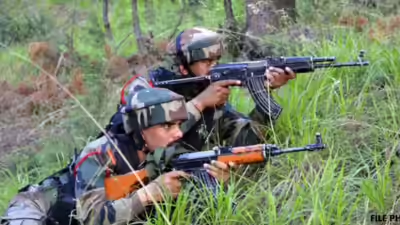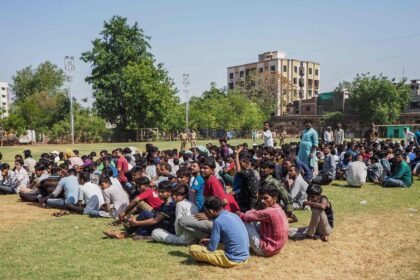Operation Mahadev Launched in Srinagar: 2–3 Terrorists Trapped After Intelligence Input
Prelude to Operation Mahadev
In the quiet pre-dawn hours of July 28, 2025, the bustling city of Srinagar stirred under the weight of something unusual. Not a siren. Not a blast. But the kind of stillness that only security agencies recognize—the stillness before action. Intelligence had been brewing over the past 72 hours. Sleeper cells, local conduits, and surveillance drones had all pointed to one message: a group of heavily armed militants had infiltrated the city’s outskirts.
This wasn’t just another encounter. It was the start of something with precision, intent, and strategic choreography. Operation Mahadev—a name chosen for its symbolic weight—was greenlit at 4:16 AM. Within the next two hours, a coordinated strike plan had unfolded across a secured radius in the Soura locality of Srinagar, marking the beginning of a high-stakes operation in the heart of the Kashmir Valley.
The Intelligence Web: From Signal to Strategy
Sources within the intelligence community confirmed that the operation stemmed from a series of intercepted communications involving operatives from a Pakistan-based terror module. What initially seemed like generic radio chatter turned into a decipherable pattern. The pattern led to coordinates, and the coordinates confirmed presence—2 to 3 militants, well-equipped and trained, holed up in a residential cluster camouflaged among civilians.
The intelligence apparatus of India is no longer what it was two decades ago. With upgraded artificial intelligence tools, heat signatures, and local informant networks, the tracking of suspected militants has shifted from crude guesswork to high-tech precision. Operation Mahadev was not just an encounter—it was an intelligence-led operation, with data from multiple agencies including RAW, IB, the Indian Army’s 15 Corps, and the Jammu and Kashmir Police.
Naming the Operation: Why ‘Mahadev’?
Symbolism plays a role in modern military campaigns, especially in counter-terrorism operations that are as much psychological as they are strategic. “Mahadev” – another name for Lord Shiva, the destroyer of evil in Hindu mythology – was deliberately chosen. It wasn’t just a codename. It was a message.
The message was clear: India was invoking its resolve to eliminate terror at the roots—ruthlessly but within the bounds of legal and operational protocol. The name, while spiritual, held no communal intent; it was chosen to signify the seriousness of purpose, a reminder that evil—however disguised—would be brought to justice.
The Urban Warfare Challenge in Srinagar
Unlike open-field engagements near the Line of Control (LoC), urban warfare in Srinagar is complex. Narrow alleys, multi-storey residential buildings, and the dense presence of civilians make operations exceptionally difficult. Terrorists embedded in such environments often have upper-hand in terms of concealment and ambush potential.
The biggest concern for the operation commanders was minimizing collateral damage. The trapped terrorists were believed to have automatic rifles, grenade launchers, and possibly IEDs. A civilian casualty would not only damage the legitimacy of the mission—it would feed anti-India propaganda across the border.
To neutralize this risk, the Jammu and Kashmir Police Special Operations Group (SOG), in coordination with the Rashtriya Rifles and CRPF, first evacuated nearby homes in a 300-meter radius. The evacuation was covert—families were quietly escorted under darkness, and external movement was frozen. By 7:15 AM, the perimeter was sealed.
Inside the Red Zone: Trapping the Militants
Using infrared scopes and drone footage, movement was detected in the top floor of a corner house. One of the terrorists reportedly attempted to escape by jumping across rooftops but was forced back by warning shots. At 8:32 AM, the first round of gunfire erupted. It was brief, precise, and intended to pin down the militants rather than eliminate.
As bullets echoed through the otherwise peaceful morning, the trapped militants responded with indiscriminate firing. A coordinated assault was ruled out for the time being. Instead, the forces adopted a “wait and isolate” approach. The goal was to exhaust the enemy—mentally, emotionally, and physically.
Civilian Safety and Media Blackout
To prevent misinformation and crowd gathering, the district administration imposed Section 144 in nearby areas. Internet services were suspended in Soura and adjoining localities to block real-time communication between possible accomplices and to curb propaganda.
Security forces requested media personnel to maintain a safe distance. As much as national channels wanted a live broadcast, the risk of revealing troop movements or giving away tactical information to terrorist handlers abroad was too high. In these scenarios, operational secrecy is paramount.
Strategic Timing Amidst Political Backdrop
Interestingly, the operation also came at a time when Union Home Minister Amit Shah was scheduled to review the security scenario in Jammu and Kashmir in a virtual meeting later this week. While officials insisted the timing was coincidental, the optics were hard to ignore.
Pakistan’s ISI-backed modules have historically activated sleeper cells or launched infiltration attempts before key political or national events. Operation Mahadev might not just be a standalone operation—it could be the start of a larger chain of neutralization missions in the coming weeks.
A City Holds Its Breath
As the day wore on and smoke billowed over Soura’s skyline, Srinagar waited. Families who had returned to normalcy after the abrogation of Article 370 were once again staring at the fragility of peace. The city, caught between its past and its promise, watched from behind closed curtains.
Operation Mahadev was far from over.
But one thing was certain—the resolve of India’s forces had entered a new chapter. Armed not just with weapons but with intelligence, strategy, and patience, they were fighting not just men with guns, but an ecosystem of terror that has plagued the region for decades.
Breaking the Silence: First Firefight of the Operation
By the time the sun had fully risen over Srinagar, the entire city knew something serious was underway. Residents of the Soura locality, long accustomed to curfews and lockdowns in turbulent times, once again found their lives paused. Around 8:45 AM, the first exchange of fire became audible beyond the cordoned area.
Eyewitnesses described it as “short but sharp.” It wasn’t a continuous barrage of bullets, but controlled bursts, aimed to test the terrorists’ defensive position and provoke a response. This method served a dual purpose: it helped triangulate the exact location of the militants and allowed the security forces to assess their firepower and aggression level.
Unlike past operations where swift armed assaults had led to unintended civilian casualties or even property damage, Operation Mahadev was being carried out with meticulous restraint. There was a sense of surgical intent—each bullet, each movement, weighed and calculated.
Ground-Level Tactics: 360-Degree Coordination
The urban layout of Soura posed a classic challenge: congested housing, narrow alleyways, unpredictable terrain. It wasn’t enough to just surround a building. Security forces had to deploy a 360-degree strategy, ensuring no escape routes were left uncovered.
At least four units were working in sync:
- Perimeter Containment Teams (led by CRPF) – blocking escape routes and keeping civilians out.
- Advance Combat Group (Rashtriya Rifles & SOG) – tasked with breaching, engagement, and neutralization.
- Sniper and Surveillance Units – perched on nearby rooftops, monitoring movement.
- Evacuation and Civilian Liaison Team – ensuring that residents trapped within the conflict radius were moved safely.
The choice to not storm the house immediately wasn’t due to hesitation—it was a reflection of strategic patience. The idea was to corner, deplete, and break the will of the terrorists through isolation, psychological pressure, and fear of inevitable capture or death.
The Militants: Who Are They?
While official names were withheld pending verification, intelligence sources strongly suspected that at least one militant belonged to Lashkar-e-Taiba (LeT), a Pakistan-backed terror group with active modules in northern Kashmir. The second, possibly younger, was believed to be a local recruit—someone radicalized within the last 12 months, with minimal combat experience but high emotional motivation.
This possible hybrid team—an experienced foreign handler and a local youth—has become a growing pattern in Kashmir’s militant operations. The outsider trains and leads, while the insider navigates terrain and lends legitimacy.
Reports also indicated that the militants had enough ammunition to sustain a prolonged firefight—including multiple AK-series rifles, hand grenades, and a suspected cache of IEDs. This detail explained the forces’ extreme caution. A wrong move could result in civilian casualties, loss of personnel, or even structural damage that might obscure evidence post-operation.
A City Under Lockdown: The Human Impact
By mid-morning, life in Soura had ground to a halt. Local shops were shuttered. Schools were suspended. Mobile internet remained off. Srinagar, which had begun to enjoy relative peace and routine in recent months, was back in a familiar state of suspended normalcy.
For residents caught within the inner cordon—nearly 40 homes—the ordeal was more than just inconvenient. It was terrifying. Several families reportedly spent hours lying flat on the floor, shielding their children, listening to the sound of boots, commands, and controlled gunfire from outside.
One resident, whose family had been evacuated just before the encounter intensified, told local reporters:
“We’ve lived with conflict, but the fear is different when you know the fight is happening just a few feet from your kitchen window.”
Another father recounted how his 7-year-old daughter refused to eat all day. “She kept asking if the men outside would break in and shoot us. How do you explain such things to a child?”
These voices—often lost in larger geopolitical analysis—highlight the emotional and psychological trauma faced by Kashmir’s civilians, caught in the crossfire of a war they neither start nor control.
Why This Operation Matters Beyond the Valley
Operation Mahadev isn’t just a tactical exercise—it’s also a strategic message, both internally and internationally. Internally, it signals to Kashmiris that terrorism will not be allowed to re-root, even if its face is local and its methods modern. Internationally, it shows India’s intent to eliminate terror threats using precision, restraint, and legality—countering narratives of excessive force or indiscriminate violence.
More importantly, it addresses the changing nature of militancy in Jammu and Kashmir. Gone are the days of massive groups infiltrating en masse. Today, terror thrives in micro-cells, often supported digitally, financially, and ideologically from abroad, but executed by one or two people at a time.
And it’s this “lone wolf + remote commander” hybrid model that makes modern operations like Mahadev more important than ever. If unchecked, a two-man cell today could inspire 20 next month.
Voices from the Forces: Behind the Helmet
Speaking anonymously, one senior officer involved in the operation shared a rare insight:
“The hardest part is restraint. When you know there’s a threat inside and you’ve got the training to finish it in minutes—but you’re told to wait, to think, to not pull the trigger until every parameter is secure. That’s what separates a professional army from a militia.”
Another officer emphasized the shift in doctrine over the years:
“Our job is not just to eliminate. It’s to prevent. To stop ideology from spreading. And that’s only possible when operations are conducted cleanly—with zero civilian harm and full transparency.”
These voices highlight a new era of counter-terrorism in India—one where bullets are used as the last resort, not the first instinct.
A Battle of Wills
As night fell over Srinagar, and the Valley braced for a long, uncertain night, Operation Mahadev entered a crucial stage. Trapped, outnumbered, and surrounded, the militants still hadn’t surrendered. Sporadic gunfire echoed through the darkness. Drone surveillance continued. Negotiation wasn’t on the table. The mission was clear: neutralize, not negotiate.
But beneath the firepower, the planning, and the headlines, was a deeper battle—a battle of narratives, of ideologies, of legitimacy. And in that battle, every move mattered.
Operation Mahadev was no longer just about two or three men with guns. It was about a region, a people, and a country reclaiming its right to peace—one operation at a time.







